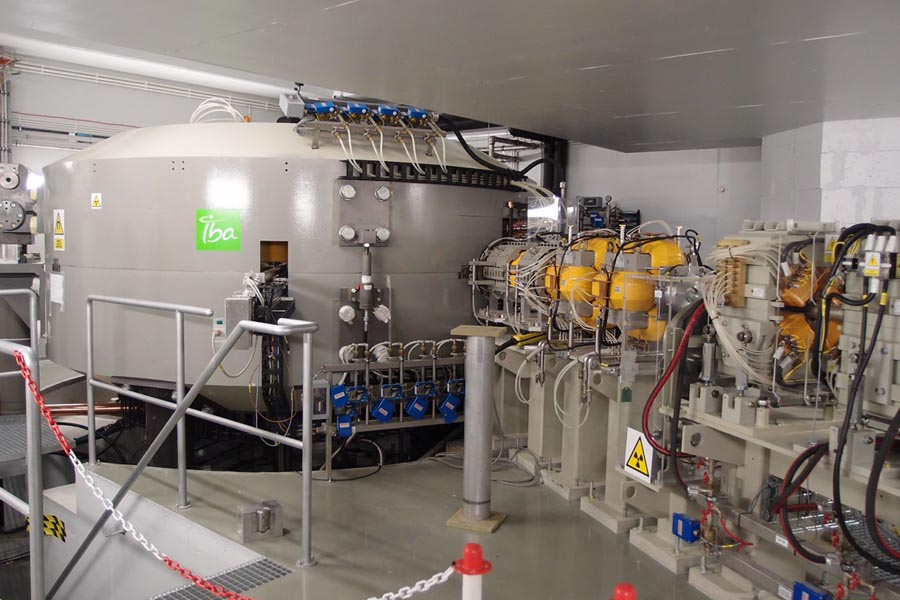
In 1896, Becquerel discovered the natural radioactivity in potassium uranyl sulfate. Since then, Pierre and Marie Curie, E. Rutherford, and F. Soddy all made tremendous contributions to the discovery of many other radioactive elements. The work of all these scientists has shown that all elements found in nature with an atomic number greater than 83 (bismuth) are radioactive. The transformation of one element into another was first demonstrated by Rutherford in 1919 Radionuclides used in nuclear medicine are mostly artificial ones. They are primarily produced in a cyclotron or a reactor. The type of radionuclide produced in a cyclotron or a reactor depends on the irradiating particle, its energy, and the target nuclei. Since they are expensive, the facilities having such equipment are limited and supply radionuclides to remote facilities that do not possess them. Very short-lived radionuclides are available only in the institutions that have the cyclotron or reactor facilities; they cannot be supplied to remote institutions or hospitals because they decay rapidly. The future of accelerator production of radioisotopes reached a turning point with the construction of the first cyclotron by E. Lawrence, Edlefsen and Livingston in 1930. With the cyclotron, it became possible to produce a wide variety of radioactive isotopes for the first time. Researchers from around the world came to Berkeley in California to use the artificially produced radiotracers such as radioactive sodium and iodine in the late 1930s. Cyclotron produced radionuclides were used in the late 1930s for biomedical research, some clinical research and basic research in biochemistry. Cyclotrons are the most commonly used devices for acceleration of particles to energies sufficient for bringing about the required nuclear reactions. The first cyclotron dedicated to medical applications was installed at Washington University, St Louis, in 1941, where radioactive isotopes of phosphorus, iron, arsenic and sulphur were produced. During World War II, a cyclotron in Boston also provided a steady supply of radionuclides for medical purposes. In the mid-1950s, a group at Hammersmith Hospital in London put into operation a cyclotron wholly dedicated to radionuclide production. The major change occurred in the early and mid-1960s when the work in hot atom chemistry (e.g. the in situ chemistry of nucleogenic atoms occurring in a target being bombarded) laid the foundations for the synthesis of organic compounds labelled with positron emitters. According to the theory of electrodynamics, the rotational frequency of a charged particle travelling in a magnetic field is independent of the radius of its orbit. The energy of the particle increases as the velocity of the particle increases. The cyclotron utilizes this fact to produce particles of reasonably high energy in a relatively confined space. The acceleration chamber of the cyclotron is placed between the poles of a homogeneous magnetic field, as shown in Fig. 1. FIG. 1. Comparison of cyclotrons: (a) a small single isotope machine; (b) a large multi-purpose research machine. An example of a simple cyclotron-produced radionuclide is 111In, which is produced by irradiating 111Cd with 12-MeV protons in a cyclotron. Thenuclear reaction is written as follow: 111Cd (p; n)111In Where 111Cd is the target, the proton p is the irradiating particle, the neutron n is the emitted particle, and 111In is the product radionuclide. In this case, a second nucleon may not be emitted because there may not be enough energy left after the emission of the first neutron. The excitation energy that is not sufficient to emit any more nucleons will be dissipated by ?-ray emission. Cyclotron-produced radionuclides are usually neutron deficient and therefore decay by b+ emission or electron capture. This characteristics of radionuclides makes available to use them in nuclear medicine for diagnostic and therapeutic purpose in different kind of oncology, cardiology and neurology disease using PET-CT or SPECT-CT. By Shukurov R.
If this page is in your subscriptions, then it will be removed. You will not see this page. If you want to unblock a user, go to the settings, the list of blocked users and click unblock